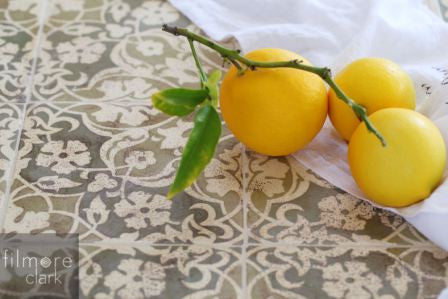Cement Tiles Go by Many Names
Cement tile go by many names and are commonly referred to as encaustic cement tile. They are made of concrete and called cement tiles to distinguish them from ceramic tiles. Cement tiles are also commonly called Hydraulic Tiles which describes the manufacturing process -- each tile is hydraulically pressed under high-pressure.
Cement tiles are also called Cuban Tiles (in Florida); Mosaicos Hidraulicos, Ladrilhos Hidraulicos, Baldosas Hidraulicas in Spanish-speaking nations; Carreaux de Ciment or carrelages du ciment (in France and Belgium). Less common names include Portugese tegels, Barcelona Tile (because they were used by Gaudi in his home city by the same name), Redondo Tile and Mission Tile.

Encaustic cement tiles, or cement tiles, are made by hand using a multi-step process. Three different layers make up each encaustic cement tile. The first layer creates the top, or patterned part of the tile. If you want additional details on the manufacturing process, be sure to read How Encaustic Cement Tile is Made.
Encaustic cement tiles are considered a "green" flooring option because the tiles are not fired in a kiln and often use locally sourced products in the manufacturing process. The tiles are perfect for both indoor and outdoor spaces not subject to hard freezes. The tiles are durable; but, need to be sealed with a penetrating sealer because they are porous.

Encaustic cement tile flooring can be customized and is very durable
Cement Tiles Differ from Encaustic Tiles
Cement tiles are often mistakenly called encaustic tiles. However, true encaustic tiles are created with an inlaid pattern of two or more different colors of clay and are more correctly called inlaid tiles. They can be confused with encaustic tiles because they may look similar.

Examples of Encaustic Tile made in the US. Image courtesy of Filmore Clark
The term encaustic originally referred to the process of enameling, but around the 19th century, the term was used to describe inlaid tile work because of its resemblance to enamel work. This may explain why encaustic tiles, made with inlaid clay and fired to create a pattern, and encaustic cement tile, made with pigmented concrete inlaid using a mold, are sometimes both called encaustic tiles.
Encaustic tile is generally frost-proof and can be used in any outdoor applications. Hydraulically pressed cement tile can't be used in locations subject to hard freezes and is more commonly found only in Mediterranean or Tropical climates. However, some pre-cast concrete tile, like our Rustic and Arabesque Cement Tile, are frost-proof and excellent for outdoor applications in frosty environments.
To be even more accurate, cement tiles should be called concrete tiles because cement is one of the materials used to make concrete. The name cement tile does distinguish them from ceramic tiles. Generally speaking, encaustic tile refers to kiln-fired clay tile. All of the other terms that include cement or concrete refer to tiles made with concrete that are usually hydraulically pressed. Whatever you call cement tile, make sure that you understand what you are buying and you won't be disappointed with the product!
